Brian Schiff’s Blog
Injury Prevention, Sports Rehab & Performance Training Expert
As I prepare to present at an ACL Symposium with some of my colleagues this weekend, I thought I would share some of the information I am presenting on injury prevention.
Research consistently shows that neuromuscular training is beneficial in reducing ACL injuries. This type of training hinges on training our athletes to land, plant and cut on a bent knee while shifting the COM (center of mass) forward. Too many times, I see female athletes land with stiff knees in an upright posture relying too heavily on their quads.
Emphasizing hip and knee flexion is vital in order to activate the posterior chain and provided a restraint to anterior tibial translation. When it comes to landing and plyometrics, I feel strongly that we need to focus on repetitive drills that enhance power and teach ideal form.
These exercises should include single and double leg varieties, but more importantly they should challenge the body in the sagittal, coronal and transverse plane. I have included a short video today that illustrates just a few exercises that I incorporate in my training sessions.
Stay tuned as I will share more details about prevention training in future posts.
First off, I want to extend warm Holiday wishes to all of you reading this blog!! As I sit at home on Christmas Eve morning, I am quietly reflecting back on a big year of accomplishments and changes I experienced in 2010. It is often hard to take time to appreciate your blessings, Because as a society we are driven to conquer the “next thing.” However, I have been trying to get better at taking time to savor life’s victories.
Last year, I ran my first marathon (thankfully under 4 hours despite horrible cramps), sold my successful 10 year-old fitness business in Ohio, and moved to North Carolina to tackle a new venture at the Athletic Performance Center. The past year has truly been full of many changes and blessings.
Over the years, I have come to realize that the real gift in my profession is being able to help others. For me, I have an ability to reach consumers through my rehab and performance training, as well as my peers through blogging, speaking and products. If you read my blog, I hope that I have been able to help you even if it is only in the smallest way.
As I look ahead to 2011, I am excited for new opportunities and feel like it will be a big year of learning and exploration for me. That will translate into more sharing on this blog and in my monthly Training & Sports Medicine Update Newsletter. I am continuing to write for PFP Magazine through my online column and will share my latest post with you today on crossing lunges.
Performing a crossing lunge presents unique challenges to the body – challenges which often exploit muscle imbalances, mobility issues, and balance deficits. It is a rotational activity that is more challenging then it may appear.
I once had an athletic trainer question the safety of them in an exercise class I was teaching. She thought they were harmful for the meniscus in the knee. Hmmm…. If that is true , why would I do them? Well, like any exercise you do in the gym, there is always risk of an injury IF you do the exercise improperly. That is a key takeaway point. For the record, I never recommend an exercise I think is dangerous – in most cases it simply comes down to form and knowing your limitations.
Crossing lunges are very effective in strengthening the entire lower body, but particularly the hips. Whether choosing the backward or forward variation, they call for hip internal/external rotation, knee stability and ankle mobility. Beyond that, they are very functional for sport and athletic movement.
Think about field or court sports for a minute. How many times does an athlete cross over to dribble, scoop up a ball or evade a tackle? You may see the forward variation more, but the backward variation is seen as well with drop steps, pivot motions and even along the baseline in tennis.
So, if you train athletes or are an athlete, this is a great example to keep in your personal exercise tool box. I have included pictures of the forward and backward version below. See the link below the photos for my full column and explanation of how to do the exercise properly.
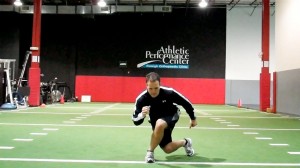
Backward Crossing Lunge (onto right)
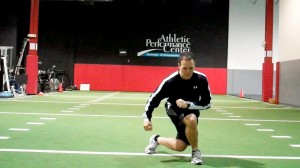
Forward Crossing Lunge (onto right)
Click here to read my full online column, Functionally Fit, pertaining to this lunging exercise. Thanks for reading this, and I wish you all the best in the year to come!
Most adult males are in search of that ever elusive six pack, right? Well, most intelligent trainers and strength coaches are well aware that there is so much more than just crunches to making the core functional.
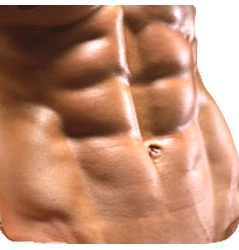
With that said, I believe abs may be one of the most over trained sets of muscles today. Some people are doing ab work daily. Why? Our abs function daily to stabilize and resist force, as well as activate trunk movements.
In reality, the aesthetics of the midsection have far more to do with nutrition and body fat than the number of crunches one does. My aim today is not to discuss this, but instead to talk about an interesting article in the latest Strength and Conditioning Journal that discusses the effects of over training the rectus abdominis on weightlifting performance.
In this article, Ellyn Robinson discusses the best way to allow athletes to stabilize weight overhead during complex lifts such as snatches, cleans and jerks. She aptly points out that if an athlete cannot stabilize the weight overhead, he/she could miss the lift in front or behind the body.
The longer I work with clients, the more hip issues I see. Generally speaking, I find the major issues to be related to decreased mobility, poor stability and muscle imbalances. These may occur in isolation or combination.
It is a no-brainer that most people have tight hip flexors and external rotators given all the sitting that takes place in our computer age. This inherently creates weakness and tightness. I feel that a natural propensity to be positioned in hip external rotation may actually reduce the firing of these muscles which in turn allows for more valgus moments at the knee and reduces lower limb stability.
Typically, female athletes fail to adequately fire the gluteus maximus (hip extension and external rotation) and prefer to dominate movement with the quads. So, how do we begin to change this?
Well, first we must focus on better hip mobility. I believe we must work to gain better hip extension by stretching the hip flexor group. I also believe we need to do this dynamically and not just passively. A dynamic approach also allows us to improve knee stability on the opposite side as we work on hip mobility. It will also allow us to resist internal rotation of the femur and the valgus moment at the forward knee.
Look at the images below:
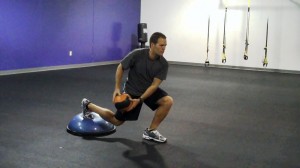
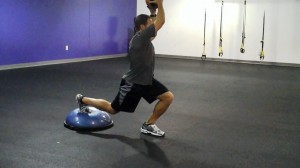
I am demonstrating a BOSU split squat diagonal chop. This is the first of a series of BOSU exercises I am doing for PFP Magazine. The upward chop forces hip extension on the right side and the downward motion reinforces firing of the left glutes to reduce internal rotation and valgus. What a perfect combo right?
To read more about this exercise, click here.
Now, you should start on the floor with just the arms and progress from there. This is a great prehab exercise or warm-up activity, but it cna also be used for strengthening too. I hope you find it as beneficial in your routine as I do.
So, I read a very interesting article yesterday in the local paper here, The Columbus Dispatch. The title was “Children May Be Vulnerable in $5 Billion Youth-Sports Industry.”
I have a vested interest in this discussion for two reasons:
- I profit directly from youth sports training in my business
- My two boys participate in youth sports
Consider some stats from this article:
- Youth sports has more than 6x the athletes than high schools
- 99% of high school coaches have also coached a youth team
- 90% of HS athletes played youth sports
- 50% began playing between 6 and 9
- 31% of athletes paid more then $1500/year to play
- 26% of those hurt while playing youth sports said their injury affected their ability to play any sports
- 20% say their parents pressured them to play youth sports
Perhaps the final bullet point may be the most disturbing, right? Who wants pressured? Well, we all know parents want the best for their kids, or so they should. Sometimes, they simply push too hard as they may want their child to get an elusive scholarship, or perhaps they are trying to live vicariously through the child.
While I am a firm believer in giving kids every opportunity to excel, there needs to be a healthy balance and perspective too. Kids at age 5 don’t need to be doing sport specific training. I don’t think elementary age kids need to be playing tackle football either. Why not work on coordination, cutting safely and general movement skills? The biggest thing I hate to see is specialization at an early age.
Kids should play multiple sports and work on multilateral sport development and not unilateral sports that often lead to overuse and premature injuries. Specializing in a sport is something to be considered during the high school years and beyond.
Back to the article. Consider this: one woman spent $30,000 to send her teenage son to IMG in Florida to train 6 days per week for 6 months. Another parent would drive through the night back to the Pittsburgh from Florida so his son could pitch on an elite team there on the weekend and be back in time for school for 3 straight months in the winter. Is this crazy or what?
I do not want to sound too judgmental, but at what emotional, psychological and physical cost do we draw the line? One 11 year old club soccer player gave the sport up because her coach screamed at her so much. Now she runs. Seriously? Coaches are driving youth athletes away and toward burnout daily due to elitism and ultra competitive coaching tactics/behaviors.
Perhaps we should be ashamed of ourselves? I try hard not to be a part of this. I will openly turn away sessions if I feel the athlete has too much other stuff going on. I did this just the other day as one mother called and said her son was playing soccer and running cross country. She mentioned he had some mild knee soreness. I know why.
I told her training with us was not a good option right now and that he should come back in the winter when he was not playing a sport. After talking, she thought this made perfect sense. She was not a pushy parent and truly understood that more is often not really better (refreshing).
One of my own athletes who has worked with me since age 10 recently had to give up the sport of soccer. She suffered multiple concussions, and now at age 16 is dealing with recurrent memory issues, medications and altered mood states. Wow! Is that the norm? No, but we must consider she plays soccer year-round and has since an early age. Her situation is not one in which the parents or coaches share any blame. The concussions are just an unfortunate risk in soccer.
However, as athletes play more competitively at younger ages, we may very well see more injuries and a higher severity as well since the exposure risk increases. It is certainly worth looking at in the years to come. Is all the training, extra practice and grueling competition really detrimental long term? It may be hard to say for sure, but if you coach, train athletes or are a parent, I beg you to consider the overall maturation and life cycle of your children as it relates ot sport.
Let them have fun and choose what they want to do. Let them be free to play and don’t look down on them if they walk away from your sport or chosen activity. Don’t be in a hurry to make them the next best (fill in the blank). Let’s all work together to make youth sports fun, safe and enjoyable again.
Oh yeah, and let’s make sportsmanship a priority again. One referee in the article was quoted as saying, “The parents are ruder. They don’t care about sportsmanship or if they are hurting a kid. They just argue.” While coaching my son in flag football this past Spring, one parent on an opposing team was trash talking. I mean really inappropriate stuff too. I never agree with this kind of behavior, but I think that at ages 4 and 5 it is utterly ridiculous. I will save that rant for another day. LOL
In the meantime, stand with me and be protectors of our youth athletes by using sound judgment, staying current on research, and listening to our kids as they grow.

